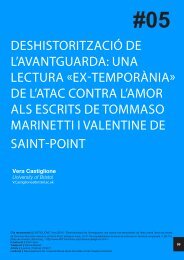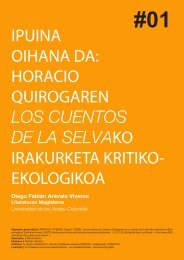03 - 452ºF
03 - 452ºF
03 - 452ºF
Create successful ePaper yourself
Turn your PDF publications into a flip-book with our unique Google optimized e-Paper software.
«So the girls can’t hear. They haven’t got beyond déjà vu. I want to keep<br />
it that way.»<br />
«What if the symptoms are real?»<br />
«How could they be real?»<br />
«Why couldn’t they be real?»<br />
«They get them only when they are broadcast,» she whispered. (DeLillo,<br />
1985: 133)<br />
We may refer here to Baudrillard’s three orders of simulacrum.<br />
This event is an example of the third-order simulacrum in which the<br />
image precedes the origin or effaces it. Baudrillard differentiates<br />
between «feigning,» which belongs to the first-order simulacrum;<br />
and «simulating,» which belongs to the third-order simulacrum.<br />
Interestingly enough, he also gives an example of illnesses; he says,<br />
«Someone who feigns an illness can simply go to bed and pretend<br />
he is ill. Someone who simulates an illness produces in himself some<br />
of the symptoms.» (Baudrillard, 1988: 168) He argues that feigning<br />
only masks reality but the difference is there, while in simulation it<br />
is rather impossible to know what is false and what is true. He also<br />
adds that, «Psychology and medicine stop at this point, before a<br />
thereafter undiscoverable truth of the illness.» (Baudrillard, 1988:<br />
169) Psychology and medicine only deal with reality, but when it<br />
comes to simulated symptoms of diseases, they stop to function,<br />
and medicine loses its meaning because it only knows how to cure<br />
real and true illnesses.<br />
So we have seen that symptoms of diseases can be simulated,<br />
and since they are simulated, they too belong to the realm of<br />
hyperreality; therefore, they cannot be falsified. To go back to déjà<br />
vu, it is interesting to note something important about this symptom,<br />
which also can be simulated. Déjà vu itself is a simulacrum since it<br />
is a mental image that precedes the original event. If we later come<br />
across a resemblance to the simulacrum in real life, we measure<br />
how much this real resemblance is real according to the pregenerated<br />
simulacrum, which proves then to be more real. The best<br />
example of this is the aforementioned «SIMUVAC,» in which the real<br />
is marginalized when compared to the simulation, so the real works<br />
as a rehearsal to the simulated which, in turn, becomes more real<br />
than the real. In the same way, déjà vu is a simulacrum generated<br />
in the brain long before the real thing happens; when the real thing<br />
happens later, we measure its reality according to the simulacrum:<br />
déjà vu.<br />
One of the most important aspects of postmodernity is the failure<br />
of signification, the endless chain of signifiers that do not reach<br />
transcendental signifieds or final meanings. In White Noise, and in<br />
the episode of déjà vu, DeLillo draws a very significant image of the<br />
floating signs and the endless chain of signifiers. We know that it is<br />
normal that people have déjà vu about things in their daily lives, but<br />
Living in a simulacrum: how TV and the supermarket redefines reality in Don DeLillo’s White noise - Ahmad Ghashmari<br />
<strong>452ºF</strong>. #<strong>03</strong> (2010) 172-186.<br />
179










